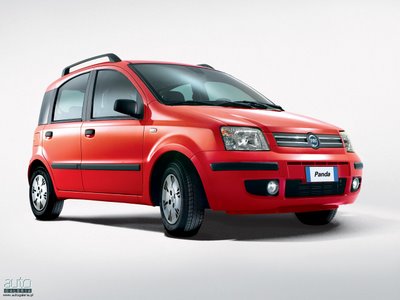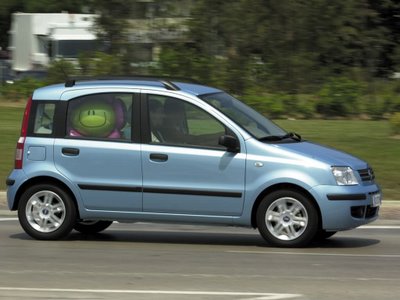Fiat Panda Five of the Best First Cars From Yahoo UK & IRELAND
Tuesday, November 07, 2006

Fiat Panda
The Fiat Panda is a city car from the Italian automotive manufacturer Fiat. The first Fiat Panda was made from 1980 to 2003 with only few changes, and is now sometimes referred to as the "old Panda". The second model, launched in 2003, is sometimes referred to "new Panda" or "Nuova Panda" (in Italian), and was the European Car of the Year in 2004.
Fiat Panda / First generation (1980-1995)
Designed by Giorgetto Giugiaro, the Panda was intended as a modern day interpretation of the Citroën 2CV or Renault 4, being a basic, simple, no-frills utility vehicle that was easy to use and maintain. Introduced in 1980, the Panda was noted for its box-like styling, which would be developed two years later in the design of the supermini Uno. Mechanically, it borrowed heavily from the Fiat parts bin, using engines and transmissions from the Fiat 127 and in certain territories, the air-cooled 652 cc 2-cylinder powerplant from the Fiat 126 was also used. The theme of simplicity was also evident in the rear suspension, which used a dead axle suspended on leaf springs.
There were many features which contributed to the Panda's "utility car" role, for example, the rear seat could be folded flat to make a bed, or folded up to act as a bottle carrier, or removed altogether to increase the load space. The front seats had removable covers so that they could be washed, the fabric covered dashboard could also be removed, and the Panda could be specified with a full-length roll back canvas roof.
Fiat Panda / Four-wheel drive and further development
In 1983, a four-wheel drive system was developed, and this proved popular in rural Italy, where roads are often very poor. The improved "Panda Super", which featured a full mesh front grille with the new Fiat corporate "five bars" insignia was launched the same year.
1986 saw some major mechanical changes to the Panda, centering on the introduction of the FIRE engines from the Uno, and a new coil sprung rear axle to address the Panda's ride quality, which had come in for intense criticism from the press and customers alike for its harsh, bouncy nature. Visually identifiable by the lack of front "quarterlight" windows, this version was known as the Mark II, although this designation did not feature on the badging.

Fiat Panda / Final years
The car's popularity remained strong throughout the 1980s and early 1990s, despite often questionable build quality. Early cars also suffered from severe bodywork corrosion, like most Fiat vehicles from that era. From 1996 onwards, the Panda began to be phased out across Europe, being a victim of tightening safety legislation. The car remained in production in Italy until May 2000. 3 years later the new Panda was launched, with total production standing at over 4.5 million units over a 20 year period.
Fiat Panda / SEAT Panda/Marbella
Spanish automaker SEAT also produced a version of the Panda. Up to 1983, SEAT lacked their own designs and only made rebadged versions of Fiat cars through a licence agreement between the two firms. Thus, there existed a Spanish version of the Panda called the SEAT Panda, produced from 1981 to 1986. After Fiat sold their share in SEAT in 1983 and the licence agreement was over, the whole Fiat-based lineup of SEAT was quickly given the least possible changes so that Fiat couldn't sue SEAT on the basis of patent infringement. The SEAT Panda had its front and rear fascias redesigned and was marketed as the SEAT Marbella from 1987 to 1998. It did not receive the major mechanical upgrades of the 1986 Fiat Panda Mark II.
Fiat Panda / Second generation (2003-present)
The new Panda, codenamed Model 169 in its development phase, was originally intended to be called "Gingo". However, this name was considered to be too similar to the Renault Twingo, so Fiat decided to continue with the Panda name. Successor to the Seicento, the new model also effectively replaced the old Panda after 23 years of production, although the Seicento itself proved still popular and remained in production. Like the Fiat Seicento, the Panda is manufactured only in Tychy, Poland by Fiat Auto Poland. A smaller, 3-door Fiat will be added to the range in 2007, the new 500.
The high-bodied Panda takes clear styling cues from mini MPVs and mini SUVs, with its taillights in particular reminiscent of much larger cars from the likes of Volvo. The Panda won the European Car of the Year award in 2004.
The Panda includes an option for split rear seats, which makes the Panda a four-seater. Since September 2005, all Pandas are equipped with stability control, ABS, EBD and at least two front airbags. The gear-lever is located high on the central dashboard, which is designed to make changing gears more comfortable than with a conventional floor-mounted gearshift.
The financially troubled Fiat needed the new Panda to be a success, and indeed it was, selling half a million units by October 2005. It sells particularly well in Italy (over half of the cars produced are sold in Italy), being seen as closer to a spiritual successor to the Fiat 500 than a replacement for either the Seicento or the old Panda. The 500,000th new Panda was built on October 5, 2005, a light blue Panda Emotions with the 1.3 L diesel engine.

Fiat Panda / Official usage
The Panda is produced for police departments (the Polish police have bought some blue and white Panda Actual models), military agencies (the Italian Army uses several dark green Panda Climbing models), and forest services (the Italian forest service has dark green Panda Climbing models).
Fiat Panda / 2005 improvements
In September 2005 several changes were made to the 2003 model, including standard fitment of ABS and a front passenger's airbag.

Fiat Panda / Editions
The basic Actual has black bumpers, lacks electric windows and a full-size spare wheel. The Actual was introduced in January 2004.
The Active, introduced in May 2003, features body-coloured front bumpers, front electric windows, and central door locking. Radio, cassette/CD player, ABS, passenger's side airbag, power steering, and manual climate control are available as options. Since September 2005, ABS and the front passenger's airbag have been made standard.
The Active Plus edition is slightly better equipped than the Active, with a cassette/CD player as standard. Production of the Active Plus stopped in December 2003.
The Dynamic edition features ABS, dual airbags, roof bars, power steering and a cassette player as standard. A CD/MP3 player, CD changer, alloy wheels, manual or automated climate control, glass sunroof and a semi-automatic transmission are available as options. Since September 2005, four airbags have been standard in some countries, with an option for two additional side curtain airbags.
The Emotion (Eleganza) edition is the best-equipped trim level. This particular trim level features significant enhancements over the Dynamic, with a standard CD player, alloy wheels with low profile tyres and automated climate control. In some countries such as the UK, the Emotion is sold as the "Eleganza".
The 4/4 Climbing edition, introduced in December 2004, has a higher ride height and larger wheels and tyres than other editions. The four-wheel drive system also makes this edition slower than others. Features are similar to those found in the Dynamic. The Climbing, however, lacks a differential lock and transmission with reductor. The Climbing edition can be distinguished by a slightly higher suspension, additional black plastic overlays on the bumpers and a "Climbing" badge just below the "Panda" badge on the left side of the rear licence plate.
The 4/4 Cross edition, similar to the Climbing, features differently shaped front and rear lights and additional side cladding. Unlike the Climbing, the Cross does have a differential lock. The Cross edition became available in January 2006 in Italy, and will be available in September 2006 in Poland, over 9 months after its introduction in December 2005.
The Actual and Active are also bases for the Actual Van and Active Van, which can be used as small vans (they also have an additional safety net behind the front seats and removable rear seats). These versions can be identified by small "Van" label on the back door.
There were rumours about a Sporting edition, with differently shaped bumpers and two new stronger engines (rated at 75 bhp and 95 bhp). This edition was to be expected in the end of 2005 or in the beginning of 2006.
During the time, many limited editions of Panda (Active and Dynamic editions only) were produced. Each of them had additional interior fittings, differentiating them from the base model.
Fiat Panda / Engines
The smallest engine, the 1.1 L petrol SOHC FIRE engine, which is rated at 54 bhp and found in the Fiat Seicento, has been criticised for being underpowered for the Panda, which weighs over 850 kg, and the acceleration in particular was considered to be very slow. However, the engine reportedly gains flexibility and power with use.
The 1.3 L MultiJet diesel engine is rated at 75 bhp and 100 ft•lbf of torque; it is the most economical of all available engines. However, this engine is detuned from the Punto (where it develops 120 ft•lbf of torque) due to the Panda's weaker transmission. Pandas with diesel engines can be easily distinguished by a "MultiJet" badge on the right side of the rear licence plate.

Fiat Panda / Top speeds
150 km/h (93 mph) with 1.1 L petrol engine
155 km/h (96 mph) with 1.2 L petrol engine
160 km/h (99 mph) with 1.3 L diesel engine
Fiat Panda / New Fiat 500
The Panda platform will form a base for a retro reincarnation of the Fiat 500 developed in collaboration with Ford. The new 500 is scheduled to arrive in 2008.
Fiat Panda / Top Gear appearances
The Nuova Panda has appeared in the BBC programme Top Gear twice:
Panda Dynamic with the 1.2 L engine (aired on November 23, 2003), tested by James May
Panda Climbing with 1.3 L engine (aired on July, 10 2005), tested by Jeremy Clarkson.
The latter managed to get onto The Cool Wall.
Source: http://en.wikipedia.org